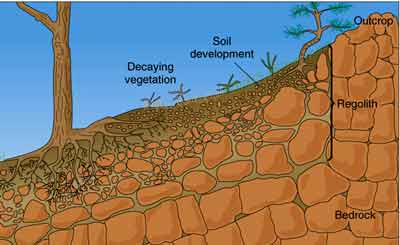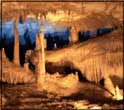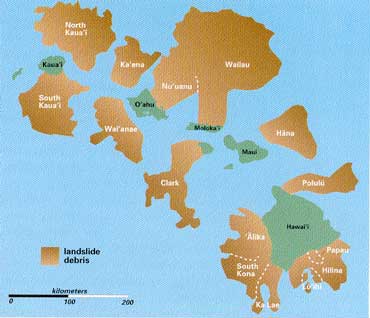THE NATURAL ENVIRONMENT
Geography 101
ToC
VALLEYS
Landslides
Patterns
Erode
Deposit
Hawai'i
Weathering and Landslides
 The
first step in breaking down mountains is weathering,
which refers to the physical and chemical dissolution of solid
rock. The solid rock underlying the surface, or bedrock,
breaks down into successively smaller pieces by both mechanical breaking
and by chemical decomposition. The resulting small mineral bits and
dissolved elements eventually move down slope simply by gravity as landslides
or with the help of an erosive force, such as running water.
The
first step in breaking down mountains is weathering,
which refers to the physical and chemical dissolution of solid
rock. The solid rock underlying the surface, or bedrock,
breaks down into successively smaller pieces by both mechanical breaking
and by chemical decomposition. The resulting small mineral bits and
dissolved elements eventually move down slope simply by gravity as landslides
or with the help of an erosive force, such as running water.
Physical Weathering
In physical weathering, rock breaks into small pieces
as a result of some mechanical force causing it to expand. Tree
roots, for example, growing into cracks, will split rock into smaller
pieces, as will ice freezing and expanding in cracks (called frost
wedging), the growth of salt crystals (called crystallization),
and expansion by water being absorbed in rocks (called hydration).
The diurnal cycle of heating and cooling can cause rock to expand, contract,
and flake off at the surface. All of these processes chip off small pieces of rock that may fall and accumulate at the base of outcrops forming talus slopes,
as shown in the photograph.
Tree
roots, for example, growing into cracks, will split rock into smaller
pieces, as will ice freezing and expanding in cracks (called frost
wedging), the growth of salt crystals (called crystallization),
and expansion by water being absorbed in rocks (called hydration).
The diurnal cycle of heating and cooling can cause rock to expand, contract,
and flake off at the surface. All of these processes chip off small pieces of rock that may fall and accumulate at the base of outcrops forming talus slopes,
as shown in the photograph.
 In
the highest mountains in Hawai'i, the freeze/thaw cycle is virtually
a daily occurrence and thus frost wedging is quite active.
Repeated cycles create a curious sorting of rock fragments into rows
called stone stripes.
Anyone walking near the summits of Mauna Kea, Mauna Loa, or Haleakala
may see these interesting
geometric
formations.
In
the highest mountains in Hawai'i, the freeze/thaw cycle is virtually
a daily occurrence and thus frost wedging is quite active.
Repeated cycles create a curious sorting of rock fragments into rows
called stone stripes.
Anyone walking near the summits of Mauna Kea, Mauna Loa, or Haleakala
may see these interesting
geometric
formations.
 On
a larger scale, if an extremely heavy weight, like an ice sheet, is removed
from a rocky region, the entire area will expand upwards as pressure
is relieved, occasionally forming exfoliation
domes in which the surface rock breaks off
in sheets.
The Half Dome (shown in the photograph) is a famous example of the
many exfoliation domes in Yosemite National Park.
On
a larger scale, if an extremely heavy weight, like an ice sheet, is removed
from a rocky region, the entire area will expand upwards as pressure
is relieved, occasionally forming exfoliation
domes in which the surface rock breaks off
in sheets.
The Half Dome (shown in the photograph) is a famous example of the
many exfoliation domes in Yosemite National Park.
|
||
BOX 1 |
Chemical Weathering
Chemical weathering breaks down and weakens rock by dissolving all or part of the mineral structure in various water solutions.
In general, increases in temperature and rainfall will increase the rate of chemical weathering. This explains why the rock beneath the world's tropical rainforests is so deeply decomposed. The tropical location of Hawai'i exposes the Islands to vigorous chemical weathering, which predominates over mechanical forms.
In chemical weathering, water solutions may attack a rock
and
dissolve only part of the matrix, leaving behind a crumbly,
corroded surface in a process called hydrolysis. Oxidation,
the brown "rust" stain that forms on rock surfaces, is another
example of chemical weathering.
A prominent form of chemical weathering is the dissolution of limestone, a process called carbonation. In carbonation, carbonic acid, a component of rainwater completely dissolves away the limestone at places where water seeps into the ground from above and near underground rivers. This process produces the world's most spectacular caverns and some interesting surface relief as well, such as sinkholes, which form when the roof of a cavern collapses.
Landslides
Occasionally, material loosened by weathering or other
processes slips downward by gravity alone as a landslide.
For our purposes, the word landslide is a general term for the movement
of loose rock and soil down slope, which includes rock falls,
rock slides, earth flows, debris flows, debris slides, and soil avalanches.  The
movement may occur suddenly, as a slope failure, or creep downward slowly
over many days,
months, or even years. In the Hawaiian Islands, landslides come in all
sizes, from tiny
ones
that
scar the hillsides to the largest known collapses on planet Earth.
The
movement may occur suddenly, as a slope failure, or creep downward slowly
over many days,
months, or even years. In the Hawaiian Islands, landslides come in all
sizes, from tiny
ones
that
scar the hillsides to the largest known collapses on planet Earth.
In Hawaiian mountains, thousands of tiny landslides, called soil avalanches, occur every year. Look into any valley and you will see bare rock and dirt scars formed by the collapse of material on the steep hillsides. In general, the higher the rainfall, the more frequent are the soil avalanches. Bit by bit, these small landslides pull down Hawaiian mountains.
Larger landslides, both debris slides (loose material only) and rock slides (loose material plus solid rock), occur in the Islands. In 1981, a huge debris slide occurred off the southwest face of Mt. Wai'ale'ale, on Kaua'i, that brought millions of cubic meters of loose material cascading down Olokele Valley. That particular event resulted from weakening the cohesion of surface material by weathering and heavy rainfall. On the Big Island, earthquakes often shake loose debris and rock slides. During the 1868 quake noted earlier (Chapter 10 -> Earthquakes), millions of tonnes of Hamakua coastline broke loose and slid into the ocean.
 Also
common are rock falls, simply chunks of rock that break
off and fall vertically. These happen in the steepest areas and are especially
common at waterfalls. At the
bottom of just about any waterfall in Hawai'i you will see a pile of
boulders accumulated from rock falls. Crater walls of the
active volcanoes Kilauea and Mauna Loa also produce many
rock
falls. These events can be dangerous as
was tragically demonstrated on May 9, 1999, when eight hikers were killed
in a rock fall at Sacred Falls on windward O'ahu.
Also
common are rock falls, simply chunks of rock that break
off and fall vertically. These happen in the steepest areas and are especially
common at waterfalls. At the
bottom of just about any waterfall in Hawai'i you will see a pile of
boulders accumulated from rock falls. Crater walls of the
active volcanoes Kilauea and Mauna Loa also produce many
rock
falls. These events can be dangerous as
was tragically demonstrated on May 9, 1999, when eight hikers were killed
in a rock fall at Sacred Falls on windward O'ahu.
 Hawai'i
is also home to the world's largest known landslides. Over the past four
million years, huge chunks of the Islands have collapsed
onto the sea floor at least 17 times. The most recent giant submarine
landslide (technically, a debris avalanche) occurred
about 100,000 years ago. Enormous blocks of land have simply dropped
away in catastrophic
slides that generated tsunami waves estimated at over 100 meters (328 feet)
in height. The ocean floor is littered with debris from these collapses
including one chunk of what used to be O'ahu that covers 500 square kilometers (200 square miles)
and rises over a 1.6 kilometers (one mile) in height.
Hawai'i
is also home to the world's largest known landslides. Over the past four
million years, huge chunks of the Islands have collapsed
onto the sea floor at least 17 times. The most recent giant submarine
landslide (technically, a debris avalanche) occurred
about 100,000 years ago. Enormous blocks of land have simply dropped
away in catastrophic
slides that generated tsunami waves estimated at over 100 meters (328 feet)
in height. The ocean floor is littered with debris from these collapses
including one chunk of what used to be O'ahu that covers 500 square kilometers (200 square miles)
and rises over a 1.6 kilometers (one mile) in height.
Some of the largest features of the Islands have been shaped by these events. The entire eastern side of the Ko'olau Volcano, for example, dropped into the ocean leaving a trail of basalt rubble that radiates out 240 kilometers (150 miles) from the O'ahu shoreline. A giant submarine landslide created the tall sea cliffs between Waipi'o and Pololu Valleys on the Big Island.
Today, the process that caused these events continues. Remember the Hilina Pali Fault System (Chapter 10 - > Folding)? Geologists believe that the slumping of Kilauea's southern flank is a prelude to the next great landslide where part of the Big Island will shear off and disappear beneath the waves.